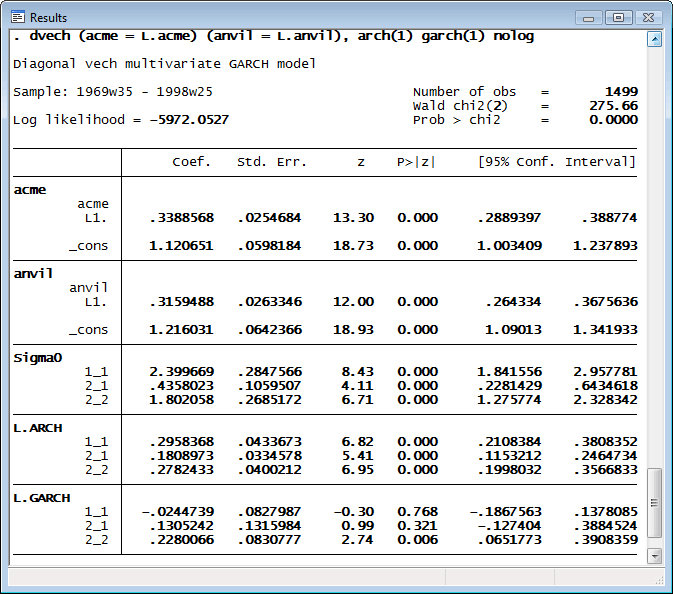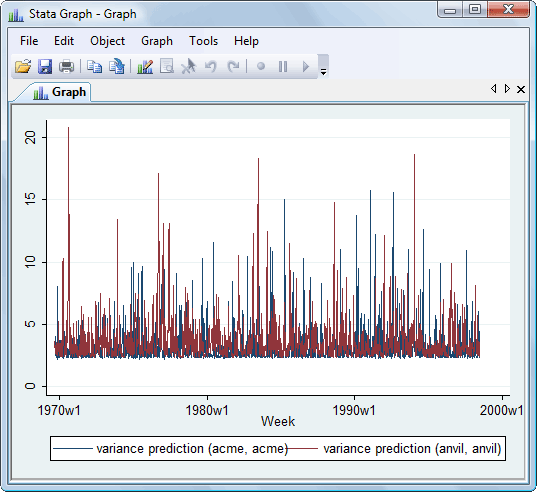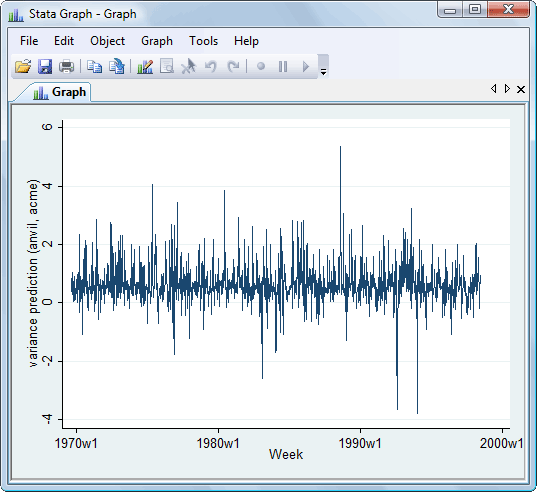

2025 Stata Economics Virtual Symposium • 6 November
Multivariate GARCH models were introduced in Stata 11.
|
| Order |
Stata’s new dvech command estimates the parameters of multivariate generalized autoregressive conditional-heteroskedasticity (GARCH) models. Multivariate GARCH models allow the conditional covariance matrix of the dependent variables to follow a flexible dynamic structure. dvech estimates the parameters of diagonal vech GARCH models in which each element of the current conditional covariance matrix of the dependent variables depends only on its own past and on past shocks.
Here we analyze some fictional weekly data on the percentages of bad widgets found in the factories of Acme Inc. and Anvil Inc. We model the levels as a first-order autoregressive process. We believe that the adaptive management style in these companies causes the variances to follow a diagonal vech GARCH process with one ARCH term and one GARCH term.

dvech supports constraints, so if we recognized that these close competitors might follow essentially the same process, we could have imposed the constraints that the ARCH coefficients are the same for the two companies and that the GARCH coefficients are also the same. We could estimate that model by typing
. constraint 1 [L.ARCH]1_1 = [L.ARCH]2_2 . constraint 2 [L.GARCH]1_1 = [L.GARCH]2_2 . dvech (acme = L.acme) (anvil = L.anvil), arch(1) garch(1) constraints(1 2)
In addition to predicting the dependent variables, we can predict the conditional variance to observe the modeled volatility. Here we make one-step predictions of volatility over the sample and graph the results.
. predict v*, variance . tsline v_acme_acme v_anvil_anvil

In the prediction above, we also predicted the conditional covariance between the two companies. Let’s graph that now,
. tsline v_anvil_acme

For a complete list of what’s new in time-series analysis, click here.
Learn
Free webinars
NetCourses
Classroom and web training
Organizational training
Video tutorials
Third-party courses
Web resources
Teaching with Stata
© Copyright 1996–2025 StataCorp LLC. All rights reserved.
×
We use cookies to ensure that we give you the best experience on our website—to enhance site navigation, to analyze usage, and to assist in our marketing efforts. By continuing to use our site, you consent to the storing of cookies on your device and agree to delivery of content, including web fonts and JavaScript, from third party web services.
Cookie Settings
Last updated: 16 November 2022
StataCorp LLC (StataCorp) strives to provide our users with exceptional products and services. To do so, we must collect personal information from you. This information is necessary to conduct business with our existing and potential customers. We collect and use this information only where we may legally do so. This policy explains what personal information we collect, how we use it, and what rights you have to that information.
These cookies are essential for our website to function and do not store any personally identifiable information. These cookies cannot be disabled.
This website uses cookies to provide you with a better user experience. A cookie is a small piece of data our website stores on a site visitor's hard drive and accesses each time you visit so we can improve your access to our site, better understand how you use our site, and serve you content that may be of interest to you. For instance, we store a cookie when you log in to our shopping cart so that we can maintain your shopping cart should you not complete checkout. These cookies do not directly store your personal information, but they do support the ability to uniquely identify your internet browser and device.
Please note: Clearing your browser cookies at any time will undo preferences saved here. The option selected here will apply only to the device you are currently using.